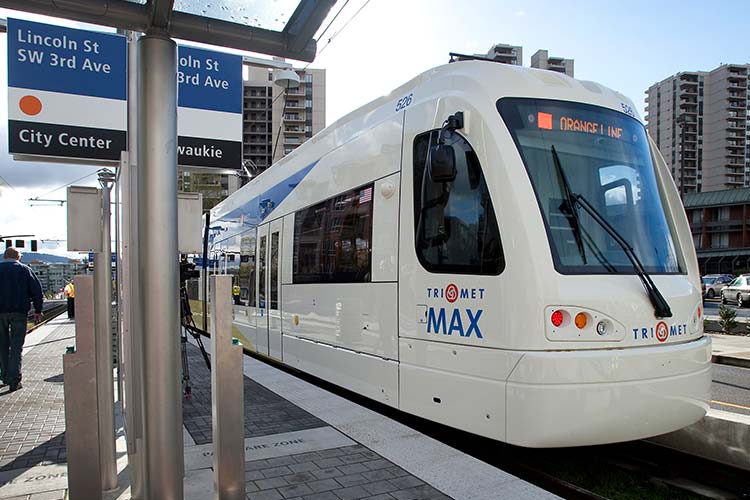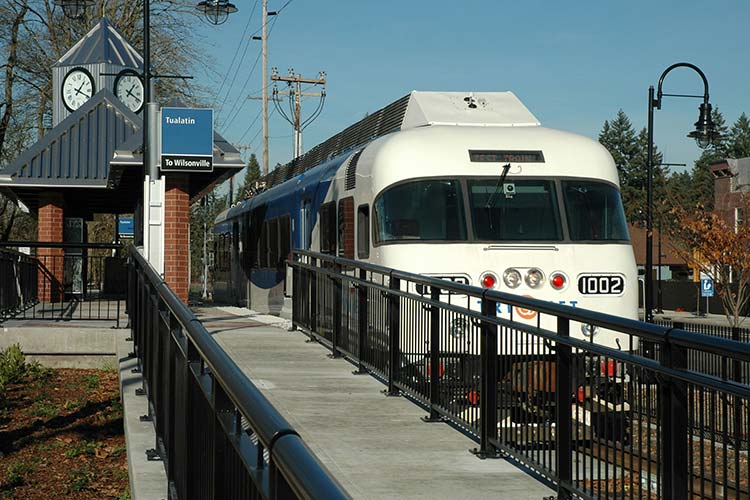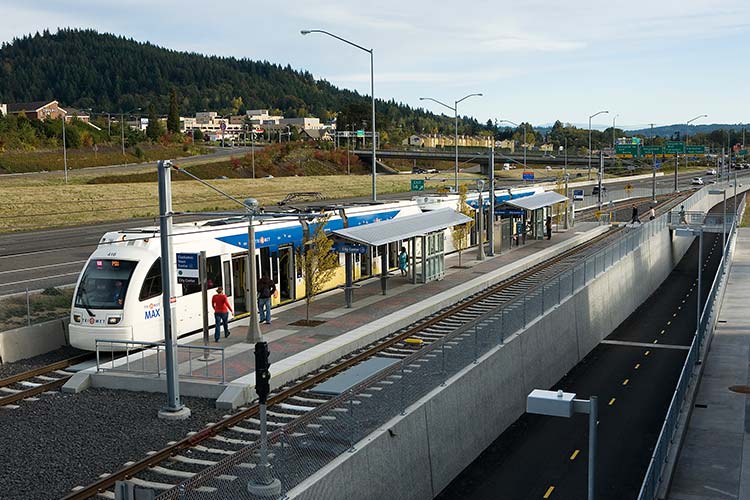The TriMet Story
Before TriMet
 After more than 45 years serving the Portland region, TriMet service continues to evolve, including this new MAX car design for 2015.
After more than 45 years serving the Portland region, TriMet service continues to evolve, including this new MAX car design for 2015.
With Portland’s transit ridership steadily falling in the 1950s and ‘60s, the area’s primary transit service, Rose City Transit Company, was faced with bankruptcy. It demanded a major fare hike, threatening to discontinue all service. Thirty-four companies had served the Portland area in the nearly 100 years previous.
January 1969
Mayor Terry Schrunk appointed a seven-member Mass Transit Advisory Commission*, who ultimately became the foundation of TriMet’s first board of directors. On January 14, the Portland City Council passed a resolution to create the Tri-County Metropolitan Transportation District of Oregon, called TriMet, to take over the local bus systems and provide regional transit service.
*Leland Johnson - Chairman, Mary A. McCravey, George Brown, Jack Meier, William E. Roberts, Alvin Batiste, Al McCready
March 1969
The Oregon Legislature passed House Bill 1808 allowing the creation of transit districts and providing them with the power to raise revenue through a payroll tax.
November 1969
 Original TriMet logo
Original TriMet logo
Rose City Transit proposed turning its operation over to City and TriMet, while maintaining title until legal resolution of fair value and pension claims were worked out.
TriMet agreed to Rose City Transit proposal, and a Memorandum of Understanding was agreed to between the City and Rose City Transit whereby Rose City Transit would turn over its property to the city at 12:01 a.m. Monday, Dec. 1, 1969, and the city would immediately transfer same to TriMet. A driver walk-out was threatened to begin within 48 hours.
December 1969
On Dec. 1, 1969, TriMet began operation, a day after Local 757 approved a new 19-month labor contract. The TriMet Board of Directors adopted a payroll tax (TriMet Ordinance No. 2) on Dec. 18, 1969.
1971
A “Transportation Plan for 1990” recommended 54 major new highway projects, many of them freeways and expressways. It predicted the declining bus system would remain insignificant as a transportation source except for the rush-hour commute to downtown.
 TriMet bus in ice storm
TriMet bus in ice storm
1973
TriMet completed an “immediate action plan” and a “1990 Master Plan” to reverse the transit system’s decline. It recommended consolidating all local bus service under TriMet, concentrating downtown service on transit malls along 5th and 6th avenues, building suburban Park & Ride lots, developing transitways in major corridors and expanding the number of buses.
The newly passed Federal Aid Highway Act allowed states to transfer funds from segments of the Interstate system no longer required to fund alternative road or transit projects. Shortly after, local jurisdictions formally rejected the $400 million Mt. Hood Freeway project in response to citizen outcry. The region sought to transfer some of the funds to transit projects. The Oregon Public Utility Commission published a report proposing a regional light rail system based largely on existing railroad right-of-ways. The Oregon Legislature adopts Senate Bill 100 establishing land-use laws to protect livability and prevent sprawl.
 TriMet buses in downtown Portland traffic
TriMet buses in downtown Portland traffic
1975
TriMet began operating Fareless Square, two years before the opening of the downtown Transit Mall — an integral part of its overall strategy to increase transit use and to reduce air pollution by eliminating short auto trips.
 Buses and pedestrian on Fareless Square
Buses and pedestrian on Fareless Square
1977
December 17 saw the opening of the downtown Transit Mall, which some believed triggered tens of millions of dollars in new downtown construction and solidified it as a retailing center.
1978
Voters approve the creation of Metro, an elected regional government with responsibility to plan for the region’s future.
 Portland Transit Mall after opening
Portland Transit Mall after opening
1979
Metro adopts the urban growth boundary (UGB) to manage regional land use and development.
1980
The first MAX line, the eastside Banfield Light Rail Project, receives federal approval to use freeway fund, using UMTA funds. Though used in Europe, the only modern US light rail had just opened in San Diego. Portland officials decided its bare bones treatment was not right for here and began to develop their own approach.
Metro adopted a new Regional Transportation Plan to focus growth within the UGB and around light rail.
 Construction of Eastside MAX light right along the Banfield Fwy.
Construction of Eastside MAX light right along the Banfield Fwy.
1986
Banfield Light Rail — named the Metropolitan Area Express or MAX for short — opened on a 15-mile alignment between the suburb of Gresham and downtown Portland, renewing rail passenger service in Portland.
A two-million-dollar grant was announced from the Urban Mass Transportation Administration that enabled purchase of vintage trolleys.
 Opening of MAX service
Opening of MAX service
1987
Vintage Trolley Inc. was formed to assure operation of the Vintage Trolley system. A Local Improvement District was formed to finance the local share of federal grant.
1991
Replicas of the Council Crest trolley cars arrived in Portland, and Vintage Trolley service between Lloyd Center and downtown Portland began November 29. Running on existing MAX tracks, largely served as an historic attraction for visitors
 Vintage Trolley grand opening
Vintage Trolley grand opening
1993
Construction began on the Westside MAX Blue Line, starting with the three-mile-long twin tunnels under Portland’s West Hills.
 Construction of the Westside MAX tunnel
Construction of the Westside MAX tunnel
1994
The downtown Transit Mall expanded north of Burnside to Union Station, opening up access to Chinatown, the Greyhound Bus station and the Amtrak station, while advancing development in the area.
1995
Metro adopted the Region 2040 Growth Concept, focusing on increased density along major transportation and light rail corridors to avoid sprawl into farmlands. Support for a downtown streetcar line grew as close-in westside Portland neighborhoods strain from growth and urban revival.
1998
An 18-mile light rail extension opened from downtown Portland through the western suburb of Beaverton to Hillsboro, serving the fast-growing high-tech corridor in Washington County. The Westside MAX extension connected with the eastside line in downtown, creating a single 33-mile alignment that was eventually called the MAX Blue Line.
Four Frequent Service bus lines were established, with service every 15 minutes or better every day.
 Opening day of Westside MAX service in Hillsboro
Opening day of Westside MAX service in Hillsboro
An Oregon-only light rail project was placed on the ballot to replace the failed South-North extension, originally proposed to extend from Vancouver, Washington, to Milwaukie, Oregon. The bond measure had been approved by the voters in Oregon but failed in Clark County, Washington. This new proposal also failed in the region, although it was supported by voters within Multnomah County and the city of Portland.
1999
Construction began on both the Airport MAX Red Line and the modern Portland Streetcar.
 Construction of the Airport MAX Red Line over the I-205 freeway
Construction of the Airport MAX Red Line over the I-205 freeway
2000
Construction began on the Interstate MAX Yellow Line. Born of Portlanders’ support for the proposed 1998 Portland to Milwaukie alignment, the Interstate alignment would serve north and northeast Portland.
Studies began on a possible commuter rail line in Washington County.
 Construction on the Interstate MAX Yellow Line
Construction on the Interstate MAX Yellow Line
2001
Airport MAX Red Line rail service began running between downtown Portland and the Portland International Airport. Modern streetcars returned to North America with the opening of the Portland Streetcar.
 Airport MAX Red Lilne grand opening
Airport MAX Red Lilne grand opening
2002
TriMet adopted a new, up-to-date look, the first change in over 20 years. The hyphen in the name was dropped, and new colors for the logo and vehicles were introduced.
Twelve more bus lines were upgraded to Frequent Service, bringing the total to 16. Riders flocked to these comfortable buses with 15-minute service, proving that adding frequency and amenities to existing routes was more effective at attracting riders than offering new, infrequent routes.
 TriMet bus and MAX with new graphic look
TriMet bus and MAX with new graphic look
2003
Metro and local governments approved the South Corridor Project, outlining transportation options for Clackamas County. Phase 1 included an 8.3-mile light rail project from Gateway Transit Center to Clackamas Town Center and along the Portland Mall between Union Station and PSU. Phase 2 included a proposed 6-mile extension from downtown Portland to Milwaukie. TriMet developed a Transit Investment Plan (TIP), a rolling five-year guide for directing transit and transportation investment in the region.
2004
Interstate MAX Yellow Line opened May 1, four months ahead of schedule, millions under budget and with enhanced bus service. TriMet’s fourth MAX extension, the 5.8-mile, $350 million Yellow Line extended from Rose Quarter Transit Center to the Expo Center — increasing the MAX system to 44 miles with 64 stations.
TransitTracker™, TriMet’s real-time arrival information system, became available over the telephone and via cell phones.
 Interstate MAX Yellow Line in front of the Rose Garden Arena
Interstate MAX Yellow Line in front of the Rose Garden Arena
2005
The opening of the 1.2-mile RiverPlace extension lengthened the Portland Streetcar line to six miles total, with 40 platform stops.
 Portland Streetcar at PSU
Portland Streetcar at PSU
2006
Construction activity began on I-205/Portland Mall MAX Light Rail project and on Washington County Commuter Rail, the first suburb-to-suburb commuter rail line in the country. A new Streetcar extension opened to provide service to the South Waterfront area (Gibbs).
 Simulation of new MAX service on the Portland Transit Mall
Simulation of new MAX service on the Portland Transit Mall
2009
More than ten years in the making, TriMet’s 14.7-mile WES Commuter Rail line opened on February 2. WES (Westside Express Service) is one of the few suburb-to-suburb commuter rail lines in the nation. WES provides service between the cities of Beaverton, Tigard, Tualatin and Wilsonville, connects to MAX Light Rail in Beaverton and adds a welcome alternative to I-5/Highway 217 for commuters in Washington and Clackamas counties.
 WES Commuter Rail at the Tualatin station
WES Commuter Rail at the Tualatin station
On September 2, the 8.2 mile MAX Green Line opened, adding a convenient and affordable way to get around for people living and working in Clackamas County and East Multnomah County. The Green Line travels alongside I-205 to Gateway and continues west to downtown Portland, where it serves the Transit Mall between Union Station and Portland State University.
 MAX Green Line at the Clackamas Town Center station
MAX Green Line at the Clackamas Town Center station
2015
Opened on September 12, 2015, the Portland-Milwaukie light rail transit line travels 7.3 miles between PSU, inner Southeast Portland, Milwaukie and Oak Grove in north Clackamas County.
Tilikum Crossing, Bridge of the People: The first of its kind multi-modal bridge in the U.S. carries light rail and streetcar trains, buses, bicyclists and pedestrians, but no private vehicles
 MAX Orange Line trains on the Tilikum Crossing
MAX Orange Line trains on the Tilikum Crossing






